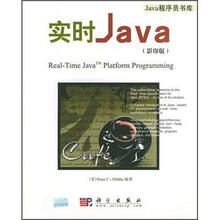实时Java(影印版)

目 录内容简介
Preface
Introduction
Chapter 1 Landscape
Java Technology and Real Time
Definition of Real Time
Java's Problem Domain
Real-Time Java's Problem Domain
Summary
Chapter 2 Architecture of the Java Virtual Machine
Write Once,Run Anywhere——Maybe
JVM Components
Interpreter Implementation
Chapter 3 Hardware Architecture
Worst-Case Execution of One Instruction
Management of Troublesome Hardware
Effects on the JVM
Chapter 4 Garbage Collection
Reference Counting
Basic Garbage Collection
Copying Collection
Generational Garbage Collection
Real-Time Issues
Chapter 5 Priority Scheduling
Scheduling Terms
Execution Sequences
Preemption]
Why32 Priorities?
Problems with Priority Scheduling
Chapter 6 Scheduling with Deadlines
Underlying Mechanism
Scope of the Scheduler
Some Systems
Timing Is Usually Probabilistic
Chapter 7 Rate Monotonic Analysis
Theorems
Restrictions
Chapter 8 Introduction to the Real-Time Java Platform
A Brief History of Real-Time Java
Major Features of the Specification
Implementation
RTSJ Hello World
Chapter 9 Closures
The Language Construct
Java Closures
Limitations of Closures
Chapter 10 High-Resolution Time
Resolution
The“Clock”
HighResolutionTime Base Class
Absolute Time
Relative Time
Rational Time
Chapter 11 Async Events
Binding a Happening to an Event
Basic Async Event Operation
Async Events without Happenings
Implementation Discussion
Chapter 12 Real-Time Threads
Creation
Scheduling
Periodic Threads without Handlers
Periodic Threads with Handlers
Interactions with Normal Threads
Changing the Scheduler
Chapter 13 Non-Heap Memory
The Advantage of Non-Heap Memory
The Allocation Regimes
Rules
Mechanisms for Allocating Immortal Memory
Mechanisms for Allocating from Scoped Memory
Using Nested Scoped Memory
Using Shared Scoped Memory
Fine Print
Quick Examples
Chapter 14 Non-Heap Access
Interaction with Scheduler
Rules
Samples
Final Remarks
Chapter 15 More Async Events
Async Events and the
The createReleaseParameters Method
Bound Async Event Handlers
Async Event Handlers and Non-Heap Memory
No-Heap Event Handlers vs. No-Heap Threads
Scheduling
Async Event Handlers and Threads
Special Async Events
Chapter 16 Reusing Immortal Memory
Using Fixed-Object Allocations
Recycling RT Threads
Recycling Async Event Handlers
Chapter 17 Asynchronous Transfer of Control
Thread Interrupt in Context
Asynchronous Interrupt Firing
Rules for Async Exception Propagation
Noninterruptible Code
Legacy Code
Use of ATC for Thread Termination
Chapter 18 Physical Memory
Physical and Virtual Memory
Physical Memory Manager
Immortal Physical Memory
Scoped Physical Memory
Chapter 19 Raw Memory Access
Security
Peek and Poke
Get/Set Methods
Mapping
The RawMemoryFloatAccess Class
Chapter 20 Synchronization without Locking
Principles of Wait-Free Queues
The Wait-Free Write Queue
The Wait-Free Read Queue
The Wait-Free Double-Ended Queue
No-Wait Queue and Memory
Implementation Notes
Chapter 21 Recommended Practices
Powerful and Easy-to -Use Features of the RTSJ
Very Powerful and Dangerous Features of the RTSJ
Very Powerful and Finicky Features of the RTSJ
Selection of Priorities
Index
Introduction
Chapter 1 Landscape
Java Technology and Real Time
Definition of Real Time
Java's Problem Domain
Real-Time Java's Problem Domain
Summary
Chapter 2 Architecture of the Java Virtual Machine
Write Once,Run Anywhere——Maybe
JVM Components
Interpreter Implementation
Chapter 3 Hardware Architecture
Worst-Case Execution of One Instruction
Management of Troublesome Hardware
Effects on the JVM
Chapter 4 Garbage Collection
Reference Counting
Basic Garbage Collection
Copying Collection
Generational Garbage Collection
Real-Time Issues
Chapter 5 Priority Scheduling
Scheduling Terms
Execution Sequences
Preemption]
Why32 Priorities?
Problems with Priority Scheduling
Chapter 6 Scheduling with Deadlines
Underlying Mechanism
Scope of the Scheduler
Some Systems
Timing Is Usually Probabilistic
Chapter 7 Rate Monotonic Analysis
Theorems
Restrictions
Chapter 8 Introduction to the Real-Time Java Platform
A Brief History of Real-Time Java
Major Features of the Specification
Implementation
RTSJ Hello World
Chapter 9 Closures
The Language Construct
Java Closures
Limitations of Closures
Chapter 10 High-Resolution Time
Resolution
The“Clock”
HighResolutionTime Base Class
Absolute Time
Relative Time
Rational Time
Chapter 11 Async Events
Binding a Happening to an Event
Basic Async Event Operation
Async Events without Happenings
Implementation Discussion
Chapter 12 Real-Time Threads
Creation
Scheduling
Periodic Threads without Handlers
Periodic Threads with Handlers
Interactions with Normal Threads
Changing the Scheduler
Chapter 13 Non-Heap Memory
The Advantage of Non-Heap Memory
The Allocation Regimes
Rules
Mechanisms for Allocating Immortal Memory
Mechanisms for Allocating from Scoped Memory
Using Nested Scoped Memory
Using Shared Scoped Memory
Fine Print
Quick Examples
Chapter 14 Non-Heap Access
Interaction with Scheduler
Rules
Samples
Final Remarks
Chapter 15 More Async Events
Async Events and the
The createReleaseParameters Method
Bound Async Event Handlers
Async Event Handlers and Non-Heap Memory
No-Heap Event Handlers vs. No-Heap Threads
Scheduling
Async Event Handlers and Threads
Special Async Events
Chapter 16 Reusing Immortal Memory
Using Fixed-Object Allocations
Recycling RT Threads
Recycling Async Event Handlers
Chapter 17 Asynchronous Transfer of Control
Thread Interrupt in Context
Asynchronous Interrupt Firing
Rules for Async Exception Propagation
Noninterruptible Code
Legacy Code
Use of ATC for Thread Termination
Chapter 18 Physical Memory
Physical and Virtual Memory
Physical Memory Manager
Immortal Physical Memory
Scoped Physical Memory
Chapter 19 Raw Memory Access
Security
Peek and Poke
Get/Set Methods
Mapping
The RawMemoryFloatAccess Class
Chapter 20 Synchronization without Locking
Principles of Wait-Free Queues
The Wait-Free Write Queue
The Wait-Free Read Queue
The Wait-Free Double-Ended Queue
No-Wait Queue and Memory
Implementation Notes
Chapter 21 Recommended Practices
Powerful and Easy-to -Use Features of the RTSJ
Very Powerful and Dangerous Features of the RTSJ
Very Powerful and Finicky Features of the RTSJ
Selection of Priorities
Index
目 录内容简介
作为RTSJ夸家组的成员之一,Dibble从Java平台特有的实时问题概述开始,依次讲解了RTSJ各项主要特性的使用方法。从广泛的实时原理到详细的编程隐患,实时Java覆盖了构建有效实时程序所需的一切知识。主要内容包括:与非实时代码的互操作性、实时开发中的取舍以及JVM软件的实时问题:垃圾收集、无堆栈访问、物理内存和“不朽”内存以及无堆栈内存的常数时间分配;优先级调度、期限调度以及速率单调分析;闭包、异步传输控制、异步事件以及计时器。
《实时Java(影印版)》是一本非常使用的指南,适用于有经验的Java平台开发人员。
《实时Java(影印版)》是一本非常使用的指南,适用于有经验的Java平台开发人员。
比价列表
公众号、微信群
 缺书网
缺书网微信公众号
 扫码进群
扫码进群实时获取购书优惠






